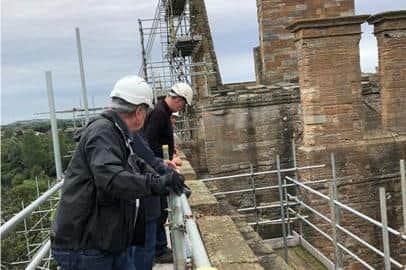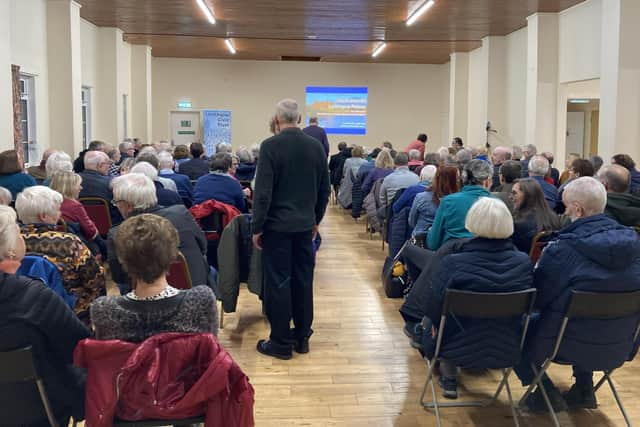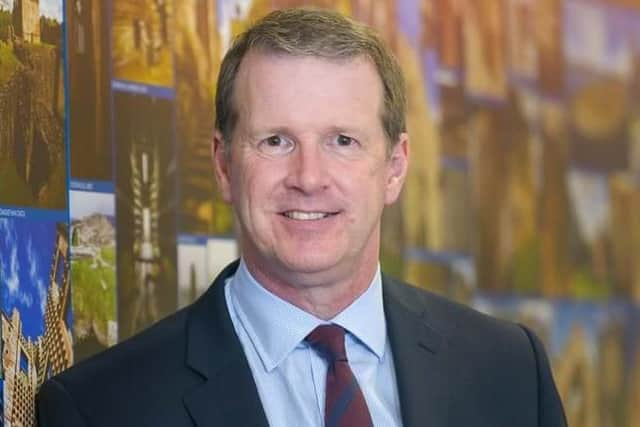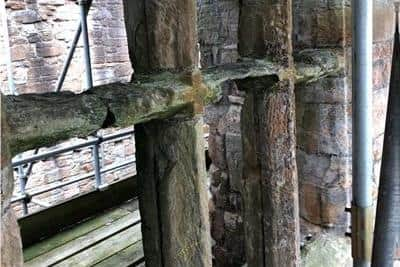Linlithgow Palace survey reveals 56 areas of high risk
and live on Freeview channel 276
For guest speaker on the evening was Alex Paterson, Historic Environment Scotland chief executive.
Little wonder then that it was standing room only in Queen Margaret Hall as the new grandad took to the podium to reveal the results of a fabric survey conducted at the Palace between October and December of last year.
Advertisement
Hide AdAdvertisement
Hide AdAfter explaining the rationale for closing some 70 of its historic sites across the country, Mr Paterson didn’t pull any punches when he revealed that 56 areas of high risk had been discovered at Linlithgow Palace by the specialist engineers.


And while 20 of those have already been tackled and fixed, there are many other areas where there are no easy and fast solutions.
However, Mr Paterson made everyone’s night by revealing that the Palace will partially re-open in the second half of May when HES staff will also return.
He said: “Fixing all of the risks will not be an overnight job; it requires a fairly major intervention in terms of repairs and it is a priority for us.
Advertisement
Hide AdAdvertisement
Hide Ad"What the Palace needs is something quite innovative and long term, not a short-term sticking plaster.


"Some thought needs to go into what that might be but it won’t be decided in a dark room in Edinburgh; we will be coming back to get your input.
"We found 56 high risk areas in different parts of the Palace; around 20 of which have already been eliminated by removing the stonework or masonry causing the difficulty.
"There are also ways of mitigating risks in the short term, while we discuss the long term solution. As a result, we will be able to partially re-open the Palace this year – but not fully.
Advertisement
Hide AdAdvertisement
Hide Ad"We've a lot of work to bottom this out but what we think is possible is re-opening mid May and allowing visitors access to the east range and fountain, the great hall, south range, toilets and shop.


"We’re also looking at the possibility of expanding the visitor experience to see if we can get people up high on the Palace to see it from another perspective.
"Our focus will be on enabling access where it is safe to do so – we’re not going to put our visitors or staff in the situation where they are at any risk.
"A huge amount of work is required on the north range and the scaffolding will have to remain there.”
Advertisement
Hide AdAdvertisement
Hide AdIt is the north range which is causing HES the most concern. Constructed of soft sandstone, it was damaged badly in the fire of 1746. The north range has since suffered greatly as the ruins were open to the elements, further eroding the masonry.


Other areas of the Palace have been affected by the elements too meaning returning visitors will notice some changes, with drop zones (crash decks as they are known) installed to ensure against any accidents.
Mr Paterson said: “I could not stand in front of you tonight and say the Palace won’t be re-opening this year – I wouldn’t have got out of the building tonight!
"We do know how important the Palace is to local people and how imperative it is for the local economy to see it re-opened.
Advertisement
Hide AdAdvertisement
Hide Ad"We are trying to move things along as fast as we can but safety is our watch word.
"We have to consider the risks to visitors and ensure that we are opening areas where the risks have been mitigated. It’s no excuse in law to say there are warning signs up.
"We’ll also be working closely with organisations in the town over the course of the summer to improve the tourist offering. We're looking at a digital audio tour of the Palace and Peel and working with the museum to loan some of our collections.”
Anne Daly from Mary’s Meanders tours asked Mr Paterson if a reduced ticket rate would be available; the answer being yes.
Advertisement
Hide AdAdvertisement
Hide AdDavid Timperly from St Michael’s Parish Church asked if HES could co-ordinate with them, as work on the crown of thorns is scheduled from May to August. Mr Paterson pledged to do so.
Councillor Sally Pattle asked HES to push for the report on the loch’s water quality, which was supposed to be published in October 2021 but the user group is still waiting. HES informed her on Thursday that the report needed further discussion with “key external partners”.
The last question of the night went to Richard Thom, who asked the HES chief if a repair diary could be filmed – as employed at Notre Dame.
Mr Paterson added: “We have been filming inspections but I’ll take that back because I think that would be a story worth telling.”
Advertisement
Hide AdAdvertisement
Hide AdMike Gunning, the civic trust’s planning spokesman and a retired architect, concluded the meeting by thanking Mr Paterson and revealing that he himself had seen the damage to the north tower.
He said: “I think we can all agree it’s really good news that the Palace is at least partially re-opening.
"As one of the civic trust members that went up on the scaffolding on the north range, I can assure you that the task up there is a mammoth one.”